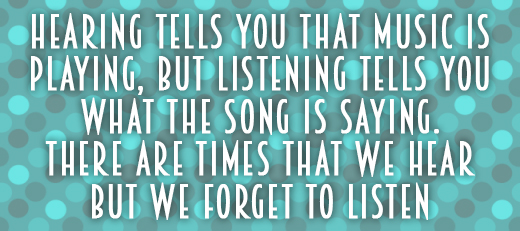Hearing vs. Listening
August 2015 Insights
In last month’s Keys to Success Insights I shared one of my favorite go to life coaching tools….creating a core message. Though the value in taking the time to establish this is a key element to enhanced communication, the skill of listening is truly the most important part of effective communication. Let’s face it, if we fail to understand what others are expressing to us, we will also fail in providing a meaningful response.
 So let’s take this month’s newsletter to expand on the essential elements of successful communication by exploring the critical difference between hearing what someone is saying to you verses listening to what they are saying. Regardless of how we’re engaged with listening, it’s important to understand that listening involves more than just hearing the words that are directed at us. There is a big difference between hearing and listening. While hearing is a physical ability-actually one of our five senses-listening is a skill. A skill that many of us have had minimal opportunity to practice. Unfortunately, most of our formal training (grades 1-12) has been directed towards writing, a mode of communication we only use 9% of the time. While comparatively, listening we use 40% of the time. Adding further to the challenge of mastering good listening skills is the fact that we as humans take in information faster than it can be spoken. The average person’s rate of listening is 400-550 words per minute while the average person’s rate of speech is 110-160 words per minute. So when we are listening, our minds may wander with its excess capacity. As a result, we can get distracted or lose focus.* It’s no wonder we confuse hearing for listening!
So let’s take this month’s newsletter to expand on the essential elements of successful communication by exploring the critical difference between hearing what someone is saying to you verses listening to what they are saying. Regardless of how we’re engaged with listening, it’s important to understand that listening involves more than just hearing the words that are directed at us. There is a big difference between hearing and listening. While hearing is a physical ability-actually one of our five senses-listening is a skill. A skill that many of us have had minimal opportunity to practice. Unfortunately, most of our formal training (grades 1-12) has been directed towards writing, a mode of communication we only use 9% of the time. While comparatively, listening we use 40% of the time. Adding further to the challenge of mastering good listening skills is the fact that we as humans take in information faster than it can be spoken. The average person’s rate of listening is 400-550 words per minute while the average person’s rate of speech is 110-160 words per minute. So when we are listening, our minds may wander with its excess capacity. As a result, we can get distracted or lose focus.* It’s no wonder we confuse hearing for listening!
Learning to truly listen to what others are saying can be the difference between becoming a good communicator or a dynamic communicator. Paying attention to not only spoken words but to also a person’s tone of voice and energy level enables us to hear between the lines and tune in to what is really being said. You can be a powerful force by learning to actively listen, consider these suggestions below:
5 Simple Steps to Active Listening
- Maintain Eye Contact: When you are looking at someone in the eye, you have no choice but to pay attention. And there will be no question about whether you are.
- Listen With A Beginners Mindset: When we are new to a situation we pay greater attention to the details and are truly present only in the moment. Often we take for granted the comfort level we have with those people and situations we are familiar with and stop listening to them with open ears, minds and hearts.
- Don’t Interrupt The Speaker: Save your questions and comments until a person finishes talking and you are able to absorb what they are saying.
- Be Attentive to Non-Verbal Cues: Paying attention to what a person doesn’t say is as important as being attentive to their words. Look for non-verbal cues such as facial expressions and posture to get the full gist of what information the person is conveying.
- Rephrase What Is Being Said To You: Once a person has finished speaking, rephrase in your own words what you believe the person is sharing with you to confirm you’re understanding them correctly. For example, you might say something like; “It sounds like you’re saying….am I on target?” or “From what I’m hearing….is that about right?”
Having someone really listen to what you’re saying can be a profound experience. Don’t underestimate the value in practicing a deeper level of listening. It is in these moments of true listening where rapport is built, trust is established, buy-in is enabled, conflict is prevented/resolved, and real potential for success is created.
Wishing You The Best Of Success
-Holly-
*footnote: http://www.wright.edu/~scott.williams/LeaderLetter/listening.htm
